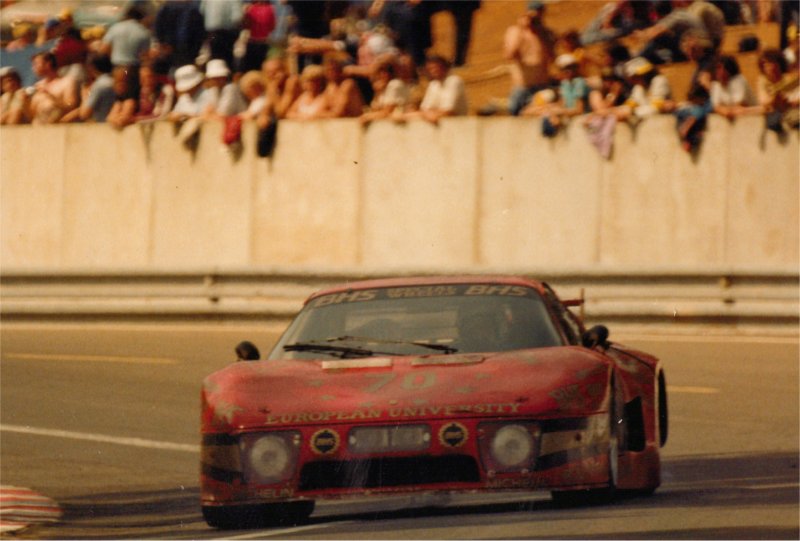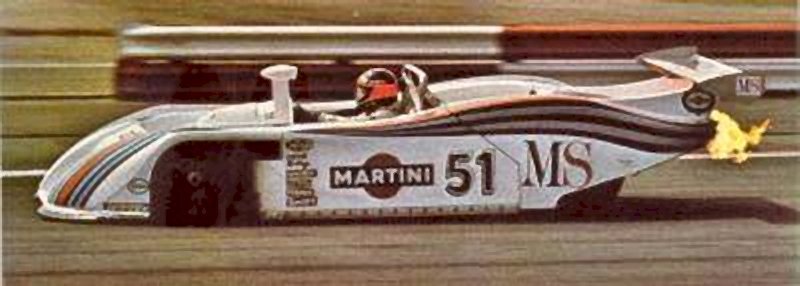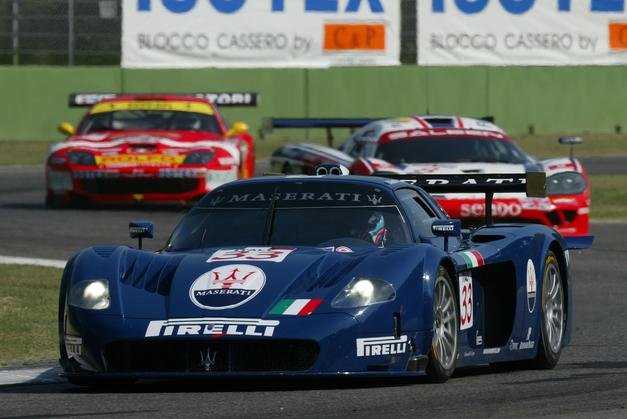Lancia, Ferrari and Maserati in Sportscar racing
In the 60s and 70s, Ferrari were the team to beat in sportscar racing. Their cars were fast, reliable and beautiful and Ford's GT40 programme was specifically designed to beat them. The film, Le Mans, is a reflection of their position in the Sportscar racing world in 1970.
However, through the 70s and 80s the Italians, now owned by the FIAT group, kept a very low Sportscar profile, being represented only by privateer entries with modified GT cars. Ferrari, as they continue to do so, concentrated on Formula 1.

Ferrari 512BB at Le Mans 1983
In the late 70s, Lancia took up the sportscar mantle for the FIAT group. Having won the World Endurance Championship in the late days of Group 5 (by the clever use of cars in both up-to and over 2 litre classes), Lancia then ran a Group 6 car for a while. This car was competitive against the Porsche 956 and was narrowly pipped to an overall victory at the Brands Hatch race in 1982, despite holding the Porsche off in the second part of the interrupted race. This was probably the best sportscar race I've ever seen.

Lancia Monte Carlo at Le Mans, 1980

Lancia Barchetta Group 6 car.
A roofed version of this car ran in private hands as the Lancia LC1, but Lancia's real Group C challenger was the beautiful LC2.
Powered by a turbocharged version of the Ferrari 308 engine, this car was probably always quicker than a Porsche, but proved fragile. It did take victories and performed well in Le Mans 24 hour races on occasions, but, despite the best efforts of drivers like Riccardo Patrese and Andrea De Cesaris, lack of 100% reliability often prevented outright victory and the project was quietly wound up in 1987, when it became clear that the LC2 could no longer compete with the Jaguars and Mercedes.

LC2 round Druids at a wet Brands, 1983

LC2 basks in the Le Mans sunshine, 1984

Privateer Lancia LC2 at Silverstone in 1985

Lancia LC2 at Brands Hatch in 1985
With the arrival of the GT series, Ferrari were ready and waiting with a supercar. Despite being launched as a road car, and ridiculed by some as a wannabe race car, the Ferrari F40 has covered itself with glory as the only car, prior the arrival of the latest generation GTs like the 911GT1 and Mercedes, to be able to take on the McLaren F1 and, on occasions, beat it (Of course, there are stories of a GT2 car from Westbury achieving this too, but more of that elsewhere...). This is even more remarkable, when you consider that the F40 ceased production in 1989.

Totip F40 at Le Mans, 1995

The end of the F40s career. Le Mans 1996
In 2004, Maserati, now owned by Ferrari, announced that they were returning to sportscar racing with a GT car.
This car was based upon the Enzo hypercar, a car with a detuned F1 engine and, when launched, caused mass dismay as it appeared to be as much a true GT as the Porsche GT1 and Mercedes CLK-GTR, which had destroyed GT racing in the late 1990s.

Maserati MC12 racing at Imola, 2004
With massive overhangs, no rear windows and developing huge downforce, the promise of true GT racing (with cars like the Lamborghini Murcielago and Aston Martin DBR9 waiting in the wings) seems to have been dealt a huge blow and it has already (after two races) proved worryingly competitive, despite attempts to reduce its competitiveness...

Maserati MC12 racing at Silverstone, 2008
The Maserati was actually hamstrung by rules and, whilst winning the FIA championship, never dominated in the way expected and didn't compete in the Le Mans series.
In fact, the Italian marques were represented in sportscar racing in the early 21st century by Ferrari.
In the top class, the 550 and later 575 front engined GT model was highly successful.

Ferrari 575 at Le Mans 2007
In GT2, the 360 (and later 430) took the fight to the Porsche armada, usually proving faster, albeit sometimes thirstier.

Ferrari 430 in Silverstone LMS race 2007
Ferrari were absent from the top level GT1 class (run on an odd 'Franchise' basis) when SRO (Stefan Ratel) and the FIA revamped it, but they followed the effective 360 and 430 up with the even faster and, perhaps, more focussed, 458 Italia as a GT3 racer.

Ferrari 458 in Silverstone GT3 race 2011
This proved very effective in the class and in national GT series across the world.
The 458 was replaced with the 488 (with a turbocharged engine) and then the 296.
However, with the arrival of the Hypercar rules to the WEC and IMSA, Ferrari returned to top level WEC sportscar racing for the first time since the 1970s with the 499P.

The Ferrari 499P at Monza in 2023
The car was quick immediately, but most impressed at Le Mans, where it won in both 2023 and 2024, although it was only bad luck or team management that denied them other wins in the first season and a half of Hypercar rules WEC.
Back To The Sportscar Racing Page
